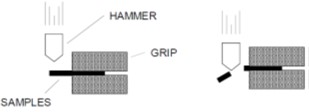
Five Tests for Low-Temperature Applications

Dilip Dhupia
Applications Engineer, India
When seals lose their flexibility and ability to respond to a reaction force at low temperature, the change is physical. Thus, the compound must be formulated for optimum performance of the final product, while ensuring the correct V/E Ratio is maintained. Seals are used in many critical applications including (but not limited to): Aerospace; Oil & Gas; Food & Dairy; Automobile; Pharmaceutical / medical; and Petrochemical.
The following test methods can be used to assess the suitability of a compound in low temperature applications. We break these out into more detail throughout the rest of this blog post.
- Brittleness test: ASTM D2137; ISO 812
- Low Temperature retraction test: ASTM D1329; ISO 2921
- Low temperature stiffening test: ASTM D1053; ISO 1432
- Low temperature compression set: ASTM D1229; ISO 815-2
- Dynamic Mechanical Analysis: ASTM D5992; ISO 4664-1
Test 1: Brittleness Test
ASTM D2137 and ISO 812

This test uses a hammer of a specific mass, moving at a specified speed toward five cured rubber samples held by a grip. The samples and the grip are cooled to a specified low temperature. The hammer strikes the samples at the specified speed and continues moving past. The temperature at which fracture occurs in three of the five samples is said to be the brittle point of the rubber compound.
Test 2: Low Temperature Retraction Test
ASTM D1329; ISO 2921
This test is conducted in the sequence as:
- Elongating the specimen
- Locking it in the elongated condition
- Freezing it to a state of reduced elasticity
- Releasing the frozen specimen and allowing it to retract freely while raising the temperature at a uniform rate
- Measuring the length of the specimen at regular temperature intervals while it is retracting, and (“ASTM D1329 Specimen Cutting Dies – CCSi”)
- Computing the percentage retraction at these temperatures from the data obtained.
The temperatures corresponding to 10% and 70% retraction are designated as TR10 and TR70, respectively. The difference between the temperature TR10 and TR70 increases as the tendency to crystallize increases. TR70 correlates with low-temperature compression set. TR10 has been found to correlate with brittle point in vulcanizates based on polymers of similar type. (“ASTM International – Sign In”) In general, the retraction rate is believed to correlate with low-temperature flexibility of both crystallizable and non-crystallizable rubbers.
Test 3: Low Temperature Stiffening Test
ASTM D1053 and ISO 1432

The test method is employed to determine the subnormal temperature stiffening of flexible polymers or fabrics coated with flexible polymers. Temperatures at which the low temperature modulus is a specified multiple or ratio of the modulus at room temperature are interpolated from the twist versus temperature curve. These specified ratios of low temperature modulus to room-temperature modulus are called relative moduli. (“Standard Test Methods for Rubber Property—Stiffening at Low …”) These temperatures at the relative moduli encompass the transition region between the glassy and rubbery states of the material under testing. (“Standard Test Methods for Rubber Property—Stiffening at Low …”)
Test 4: Low Temperature Compression Set
ASTM D1229 and ISO 815-2
Rubber products, such as hydraulic seals on planes, submarine hatch gaskets, and hydraulic brake cups, may be exposed to varying temperature extremes. This test method provides a means of determining the extent to which recovery from compression at normal ambient temperatures is inhibited upon release of the compressive force during subsequent exposure at low temperatures.
At room temperature, a test specimen is compressed to 25% of its original thickness and exposed for a specified time at a specified low temperature. Upon release from compression, the specimen is allowed to recover while remaining at the test temperature.
The residual deformation of the specimen is measured 10 s and 30 min after removal from the compressive device.
Test 5: Dynamic Mechanical Analysis
ASTM D5992 and ISO 4664-1
DMA stands for Dynamic Mechanical Analysis. “ASTM D5992 describes tests for determining glass transition temperature via DMRT and tan delta data.” (“LOW TEMPERATURE TESTING OF ELASTOMERS”) A frequency of oscillation is chosen, and the temperature is ramped up from a temperature well below Tg. (i.e., the test uses temperature sweeps at a given frequency). The point at which tan delta reaches a maximum is said to be the material’s glass transition temperature. Once again, time and temperature are directly coupled via a specified heating rate, and again time and temperature effects are indistinguishable. ASTM D5992 also describes a method of determining Tg using results for E’’, or loss modulus.
At low temperature physical changes dominate over chemical changes in rubber seal. At low temperature sufficient flexibility of seal is desired to overcome initial drag for the elastomer to adjust its shape to maintain the seal lip to provide sealing action. Whist cold and inflexible seam may result in damage to seal lip and in turn sealing action is lost. Premier RPA + SZ is an effective DMA in torsional shear mode to provide data on V/E ratio and low temperature flexibility of seal rubber compound. The instrument is designed to measure the mixed rubber compound processability, cure properties and cured dynamic properties in a one test definition. It reduces the cycle time by approx. 35%.
Related Links
Webinar: FT Rheology via LAOS
Webinar: FT Rheology via LAOS (Large Amplitude Oscillatory Shear Learn...
Read MoreWebinar: The Future of Thermoset Testing
The Future of Thermoset Testing: A Look at the Latest...
Read More





